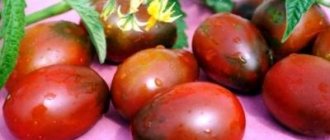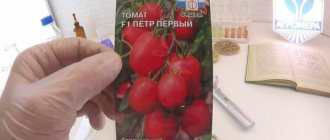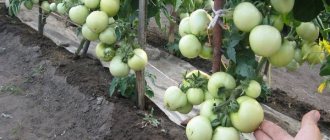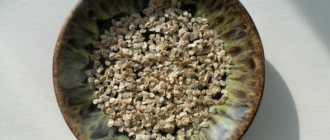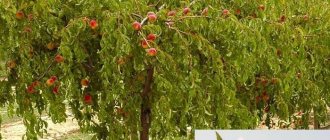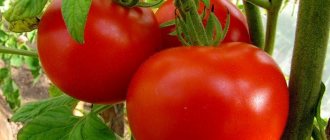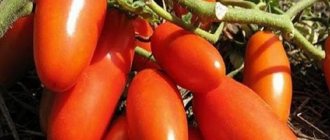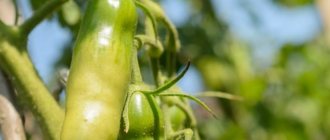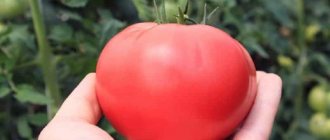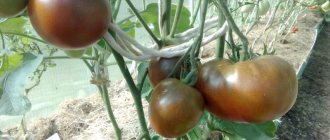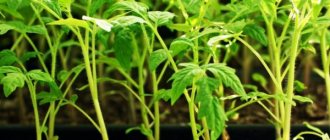Many varieties and hybrids of tomatoes with fruit names have already been created: Orange, Banana, Persimmon, Emerald Apple, Raisin, Siberian Date, Red Pear. Peach joins this rich collection. The tomato looks similar to the fruit of the same name, and in addition, it has a dessert taste.
- 2 Description of the Peach variety
2.1 Video: what peach tomatoes look like using Scheherazade as an example
- 3.1 Video: abundant fruiting of low-growing tomatoes, growing tips
Official information
The hybrid was obtained by breeders of Agrofirma Gavrish LLC, Moscow, Russia. For four years, variety testing work was carried out in all regions of the country, and in 2002 the hybrid was entered into the register of breeding achievements of the Russian Federation under number 9806105.
The tomato is recommended for growing as an early tomato in all regions in garden plots and small farms under greenhouse shelters and in open ground.
A universal tomato. It is recommended to be used as a salad, for whole-fruit canning and processing.
Description of the series
There is only one variety in the register, “Peach F1,” but entrepreneurs have created a whole series of unknown varieties and hybrids. They began to add color to the first word (pink, red, orange, yellow).
Sometimes confusion arises due to typographical nuances. For example, the picture shows a fruit with a clearly orange color, but the fruits obtained from the seeds have a beautiful “peach” color and fully correspond to the hybrid.
Sometimes, when reading the description of the series, you can come across that the fruits of tomatoes and peaches are supposedly shaggy, that is, their skin is not smooth, but rather velvety. However, it is not. When testing varieties, registration commissions accurately indicate this characteristic in the description, such as the “Shaggy Bumblebee” variety, where it is indicated that the surface is pubescent. U
Pest and disease control
The main damage to tomatoes is caused by late blight, which develops during the rainy season or when the air humidity in the greenhouse is high. The infection covers the entire aerial part; fruits with signs of fungus are not suitable for consumption.
To prevent the disease, 6 days after planting the seedlings, the tomato is treated with copper sulfate. Spray again after flowering. If prevention is unsuccessful, use Fitosporin or Hom.
When the first signs of pests appear, for example, aphids, whitefly caterpillars, and Colorado potato beetles, the tomato is sprayed with Iskra Bio. In case of mass accumulation of insects, “Commander” is used.
"Peach F1"
Characteristics and description
An original, legalized, early hybrid bred by breeders. After complete seed germination, maturation can be seen at 85-95 days.
The plant is determinate, standard, they say that they grow themselves. The height of the bush does not exceed 50 cm. The bush does not require pinching and rarely needs garters and fixation of fruit branches.
The leaf blade is small, dark green in color. The inflorescences are simple, the first can be seen above 7-8, and then after 1-2.
The fruit formation is round and smooth. An unripe tomato is light green in color. Starting to ripen, the greens disappear and the fruit becomes creamy. If its side falls on the sunny side and is not covered by foliage, then it acquires a light “tan.”
When cut open, the seed chambers of a not very dense tomato may not be visible. Officially there are 2-3 of them, but they are completely filled with pulp and there are not many seeds.
The fruits are not large, ranging from 100-105 g, all tomatoes are equal in size, shape and color. The tomatoes fit perfectly into the neck of the jar and can be taken out just as well. The skin of the fruit is thin but durable. The fruits do not crack in the garden and withstand heat treatment well, remaining intact in the jar.
Tomato products (juice and ketchup) are very thick, some say they have the consistency of gelled puree.
Tasters rated the “Peach f1” tomatoes as “good.” Those vegetable growers who have already tried the fruit describe the taste as delicate and balanced.
The yield of the hybrid is not high. In closed ground, its commercial value does not exceed 8 kg per sq. m., and in open ground no more than 5 kg/m2.
Advantages:
- early ripening of fruits;
- good product yield;
- ease of cultivation;
- no need for garters;
- original coloring.
Reviews
Galina Vasilievna, 64 years old When caring for tomato bushes, it is recommended to regularly tear off the lower leaves so that the tops do not come into contact with the ground and do not deteriorate. When watering, it is important to observe the following rule: before flowering begins, water should come from above or by “rain” method. As soon as the bushes begin to bloom, watering should be carried out at the root. If mineral components are added to the water for the purpose of fertilization, it is extremely important not to touch the green tops during watering.
Ivan Sergeevich, 39 years old As a preventive protection, you can use a two-day ash infusion with the addition of grated laundry soap. To do this, take about a liter of sifted wood ash and no more than 100 - 150 g of grated laundry soap per bucket of water. Immediately before use, the mixture must be thoroughly mixed. Spraying should be carried out not only on the leaves and stems, but also on the root soil. The benefit of using wood ash also lies in the ability to neutralize the acidity level of the soil, thereby ensuring a good harvest of tomatoes.
"Peach pink"
This tomato is supplied to the market.
Characteristics and description
The photo of the seed packet shows bright crimson tomatoes with a spiky growth. What the packer saw in common between the fruit and the peach is not clear.
The description says that tomatoes weighing up to 50 g, clustered, 20 pieces per cluster.
The Pink Peach tomato is recommended for fresh consumption and processing into tomato products.
The indication that the fruit contains up to 7.5% sugar is slightly confusing, since biochemists have never been able to record such a percentage in tomatoes.
The manufacturer is silent about the ripening time, but the indication that sowing begins in early April suggests that it may be an early hybrid. Designed for growing in open ground.
Advantages and disadvantages
Those vegetable growers who have already tried the seeds of the “Russian vegetable garden” share their impressions and say that there are no more than 6 tomatoes in a bunch and they are located very rarely. The bush grows up to two meters, but you should not rush into pinching, since there are not many fruits.
Vegetable growers also did not notice the amazing, sweet taste and noted the sourness, but the appearance of tomato fruits is beautiful, uniform, and even.
Resistance to diseases and pests
Vegetable growers describe that the tomatoes of this manufacturer are quite resistant and have not been subjected to special attack by fungal and bacterial infections.
The one who brought the hybrid to the market claims that the tomatoes are resistant to nematode attack.
Features of growing the variety
Since the variety is very tall, unlike the original “Peach F1”, it needs to be tied to stakes and pinched in a timely manner.
It is recommended to cultivate the crop in 3-4 shoots, since the yield of one shoot is very small.
When growing a tomato, it needs:
- watering;
- weeding;
- feeding;
- mulching;
- formation;
- tying;
- preventive treatments against diseases.
Features of cultivation
Seeds are initially prepared for planting. Usually soaked in a weak solution of potassium permanganate to prevent the occurrence of diseases. Then some use special growth stimulants in which the seeds are soaked overnight. Next, the seeds are usually placed on damp material for hatching.
Seedlings are sown in March-April in special soil for tomatoes and peppers. Sowing depth is 1 cm, the distance between plants is about 1 cm. Cover with film for several days to create sufficient moisture. When germination occurs, open. Water not often, but generously. Do not allow water to get on the leaves, this will destroy the plants.
When 2 full sheets appear, they are seated in separate cups (picking). Picking containers are chosen with holes in the bottom. Picking is needed to strengthen the root system and the plant as a whole. When the plant has about 10 full leaves and its growth is 20-25 cm, planting in open ground or a greenhouse is possible. Usually on the 50th day after planting. Before planting in the ground, seedlings are usually hardened off, the windows are opened for several hours, or taken out into the fresh air.
The soil temperature during planting should be at least 20 degrees. Plants are planted around mid-May. You can plant them in the greenhouse earlier. For open ground, special shelter from the cold must be provided. Immature plants cannot withstand weather conditions.
Tomatoes are usually planted in a checkerboard pattern, at a distance of about 40 cm from each other. The gap between the rows should be approximately 70 cm. When planting in a permanent place, holes should be prepared filled with mineral fertilizer or mullein. A few weeks before planting, the soil is dug up with humus and disinfected with copper sulfate. Warm up using shelters. Good predecessors for tomatoes are cucumbers, zucchini, and carrots. Do not plant in areas where potatoes grew last year.
Tomatoes are planted in cloudy weather, or in the evening, so that the sun does not shock the plants. After planting, the tomatoes are well watered at the root and left without action for a week and a half. After this, regular fertilizing with mineral fertilizers, every one and a half weeks, is relevant. Mulching and loosening have a good effect on plant growth. Watering is not frequent, abundant at the roots. The variety does not require pinching. Only the formation of a bush into one stem.
A garter is required only in the case of multiple fruits. The garter is carried out to individual pegs or trellises with ribbons made of synthetic materials; other materials can cause rotting of the stem. Flowering occurs in mid-June; after fruit set, it is necessary to stop interfering with the soil, except for watering. Harvest at the end of June. It will have time to ripen again if new seedlings are available.
Read also interesting articles about planting tomatoes in the garden: how to properly tie and mulch? How to build a mini-greenhouse for seedlings and use growth stimulants?
"Peach red"
The situation with red peach is interesting, since this tomato is offered to vegetable growers by two companies:
- "Russian vegetable garden";
- "Sedek"
Characteristics and description
To describe the “Red Peach” tomato you need to work hard, since companies provide completely different information.
At the “Russian Garden” tomato:
- hand (20 tomatoes per hand);
- weight 35-40 g;
- fruits with a “spout”;
- bright red color;
- nematode resistant.
U
- early-medium in maturity;
- indeterminate;
- pink-red in color;
- weight up to 200 g;
- Recommended as a salad and for processing.
It is difficult to find reviews from vegetable growers about growing both, so when buying seeds, rely on your own strengths and possible inconsistencies.
Advantages and disadvantages
Peach is a rather rare variety. Suitable for lovers of collectible exotic tomatoes; they are not grown en masse. The yield is low, so the variety is not used on an industrial scale. This is a good option for planting a tomato in a small summer cottage, since the bush does not take up much space.
After harvesting, Peach tomatoes are stored for no more than three days.
pros
- unusual appearance;
- good taste;
- leveled fruits;
- versatility in use;
- possibility of cultivation in any way;
- does not require the formation and pruning of the bush;
- takes up little space;
- drought-resistant;
- not prone to cracking;
- resistant to most infections.
Minuses
- average yield;
- does not tolerate shade well;
- short shelf life;
- does not tolerate transportation;
- susceptible to late blight.
"Peach orange"
Tomato “Orange Peach” can be bought in online stores, but there is no indication of the originator of the variety, manufacturer or author. There is no color packaging with photos.
Official information
Unofficial sources describe the variety as the result of an accidental cross-pollination of Mini Oran and Yellow Peach varieties in the fields of James Weaver. Since these varieties are very old and very sweet, the tomato turned out with an increased dose of sugars and dry substances.
Characteristics and description
The fruits are not large, their size is compared to a golf ball.
The description of the taste and consistency suggests that a tasting rating of “excellent” is possible, but you need to become the owner of these original seeds.
A special feature of the fruit is its unusual skin. It is covered with thin fibers, which resemble the velvet surface of a peach.
Advantages and disadvantages
Among the advantages of this variety, manufacturers indicate:
- amazing taste;
- wonderful aroma;
- an unusual type of tomato.
Features of growing the variety
Since the description does not indicate whether the vegetative form belongs to any species, it is better to start growing carefully and carefully monitor the growth force.
If the first cluster is in no hurry to set, then most likely the tomato is indeterminate. However, you can’t rush to shepherd either. Since the fruits are not large and few can be set, removing the stepsons can significantly reduce the yield.
But fertilizing and watering must be carried out regularly and in a timely manner, since we do not know the potential, and our calmness may simply not allow the plant to show it. Fertilizing should begin 2 weeks after planting in open ground, and then regularly every 14-16 days, alternating mineral and organic fertilizers.
Do you need a "peach"?
When analyzing varieties and hybrids of peach tomatoes, reviews from someone who has already enjoyed “peaches,” one involuntarily gets the impression that this series has a number of shortcomings and the main one is a strong misgrading. As a result it is difficult:
- decide on sowing time;
- conditions and need for stepsoning;
- landing place;
- amount of seed;
- the need for cultivation.
Perhaps someday, breeders will develop the “Peach” tomato variety and it will be as desirable and in demand as its stone fruit of the same name. Until this happens, give preference to varietal, legalized tomatoes, which, with their genetic potential, will guarantee a tasty and rich harvest.
